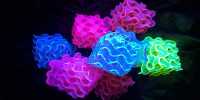Amorphous silicon (a-Si) is a non-crystalline form of silicon that is used in solar cells and thin-film transistors in liquid crystal displays. Amorphous silicon lacks long-range order, in contrast to crystalline silicon, which has a highly ordered and repetitive atomic arrangement. Amorphous silicon has unique electronic and optical properties due to its disordered structure.
It is deposited in thin films onto a variety of flexible substrates, such as glass, metal, and plastic, as a semiconductor material for a-Si solar cells, or thin-film silicon solar cells. Amorphous silicon cells are notoriously inefficient.
Some key characteristics of amorphous silicon
- Electronic Properties: Because it is a semiconductor, its electrical properties can be tuned by doping it with specific elements. It is widely used in thin-film transistors (TFTs), which are essential components of liquid crystal displays (LCDs), organic light-emitting diode (OLED) displays, and other electronic devices.
- Optical Properties: It has good transparency in the visible light range, making it suitable for photovoltaic applications. For solar energy conversion, thin-film solar cells based on amorphous silicon have been developed.
- Solar Cells: Thin-film amorphous silicon solar cells are also known as “a-Si solar cells” or “amorphous silicon solar cells.” These cells are lighter and require less material to manufacture than traditional crystalline silicon solar cells. However, they are generally less efficient, and their performance can deteriorate over time.
Applications
Amorphous silicon TFTs are widely used in the manufacture of flat-panel displays such as LCDs. These thin-film transistors function as switching elements in the display’s individual pixels, allowing for precise control of each pixel’s brightness. Because of its ability to convert X-rays into electrical signals, it is also used in X-ray detectors. This application is widely used in medical imaging devices such as X-ray machines.
Disadvantages
Amorphous silicon differs from other allotropic variations such as monocrystalline silicon, which is made up of a single crystal, and polycrystalline silicon, which is made up of small grains known as crystallites. Despite its advantages in some applications, amorphous silicon has some drawbacks. Its electronic properties are generally inferior to those of crystalline silicon, and it may suffer from long-term stability issues. Researchers are still looking into ways to improve the performance and stability of amorphous silicon-based devices used in a variety of technological applications.














